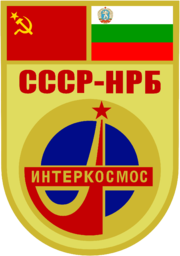 | |
| Operator | Soviet space program |
|---|---|
| COSPAR ID | 1979-029A |
| SATCAT no. | 11324 |
| Mission duration | 1 day, 23 hours and 1 minute |
| Orbits completed | 31 |
| Spacecraft properties | |
| Spacecraft type | Soyuz 7K-T |
| Manufacturer | NPO Energia |
| Launch mass | 6,860 kg (15,120 lb) |
| Crew | |
| Crew size | 2 |
| Members | Nikolai Rukavishnikov Georgi Ivanov |
| Callsign | Сатурн (Saturn) - "Saturn" |
| Start of mission | |
| Launch date | April 10, 1979, 17:34:34 UTC |
| Rocket | Soyuz-U |
| Launch site | Baikonur 1/5 |
| End of mission | |
| Landing date | April 12, 1979, 16:35:40 UTC |
| Landing site | 320 km (200 mi) SE of Dzhezkazgan |
| Orbital parameters | |
| Reference system | Geocentric[1] |
| Regime | Low Earth |
| Perigee altitude | 198.6 km (123.4 mi) |
| Apogee altitude | 279.2 km (173.5 mi) |
| Inclination | 51.61° |

| |
Soyuz 33 (Russian: Союз 33, Union 33) was an April, 1979, Soviet crewed space flight to the Salyut 6 space station.[1] It was the ninth mission to the orbiting facility, but an engine failure forced the mission to be aborted, and the crew had to return to Earth before docking with the station. It was the first failure of a Soyuz engine during orbital operations.

The two-man crew, commander Nikolai Rukavishnikov and Bulgarian cosmonaut Georgi Ivanov, suffered a steep ballistic re-entry, but were safely recovered. The original intention of the mission had been to visit the orbiting crew for about a week and leave a fresh vehicle for the station crew to return to Earth in. The mission failure meant that the orbiting Salyut 6 crew lacked a reliable return vehicle as their Soyuz had the same suspect engine as Soyuz 33. A subsequent crewed flight was canceled and a vacant craft (Soyuz 34) with a redesigned engine was sent for the crew to use.
